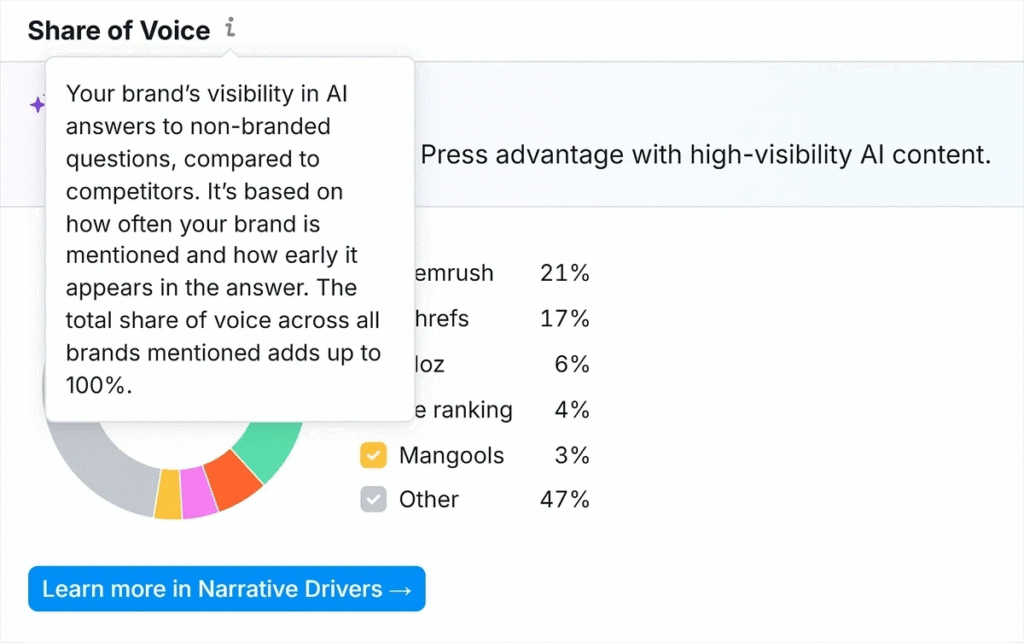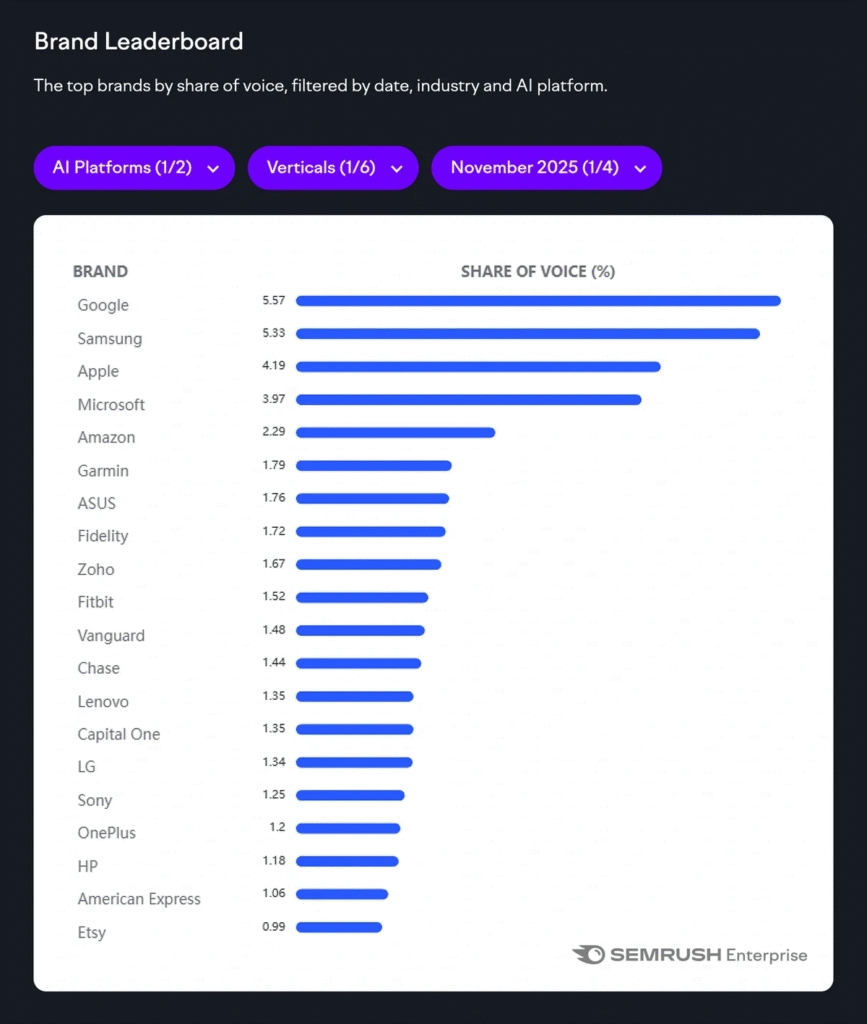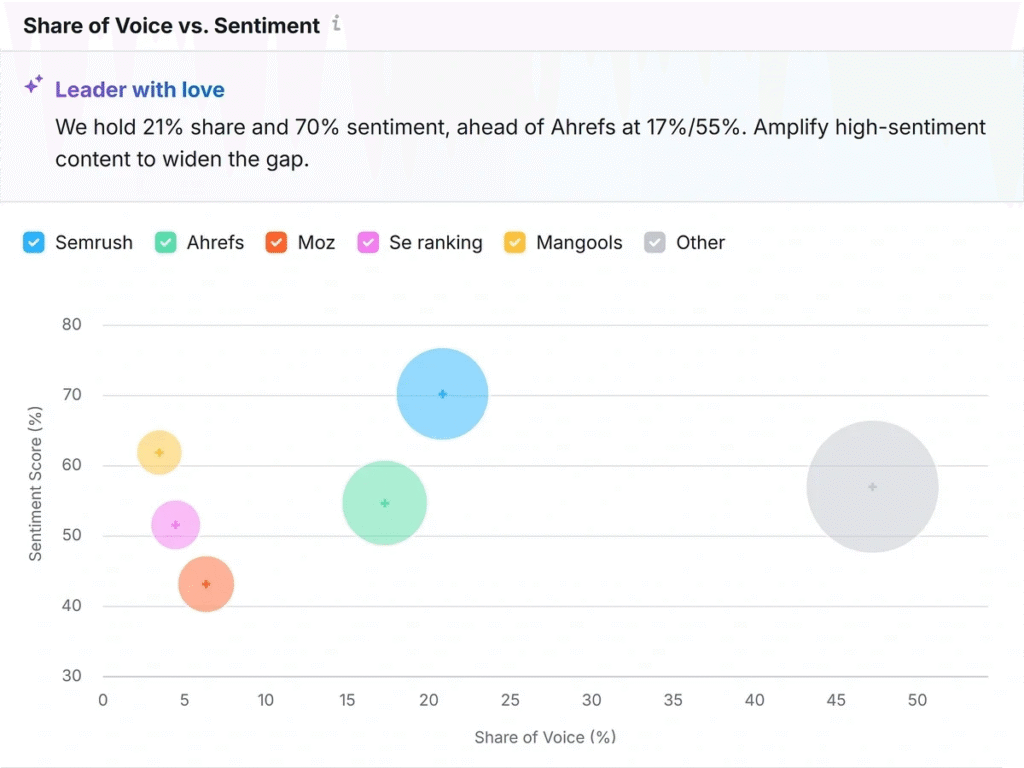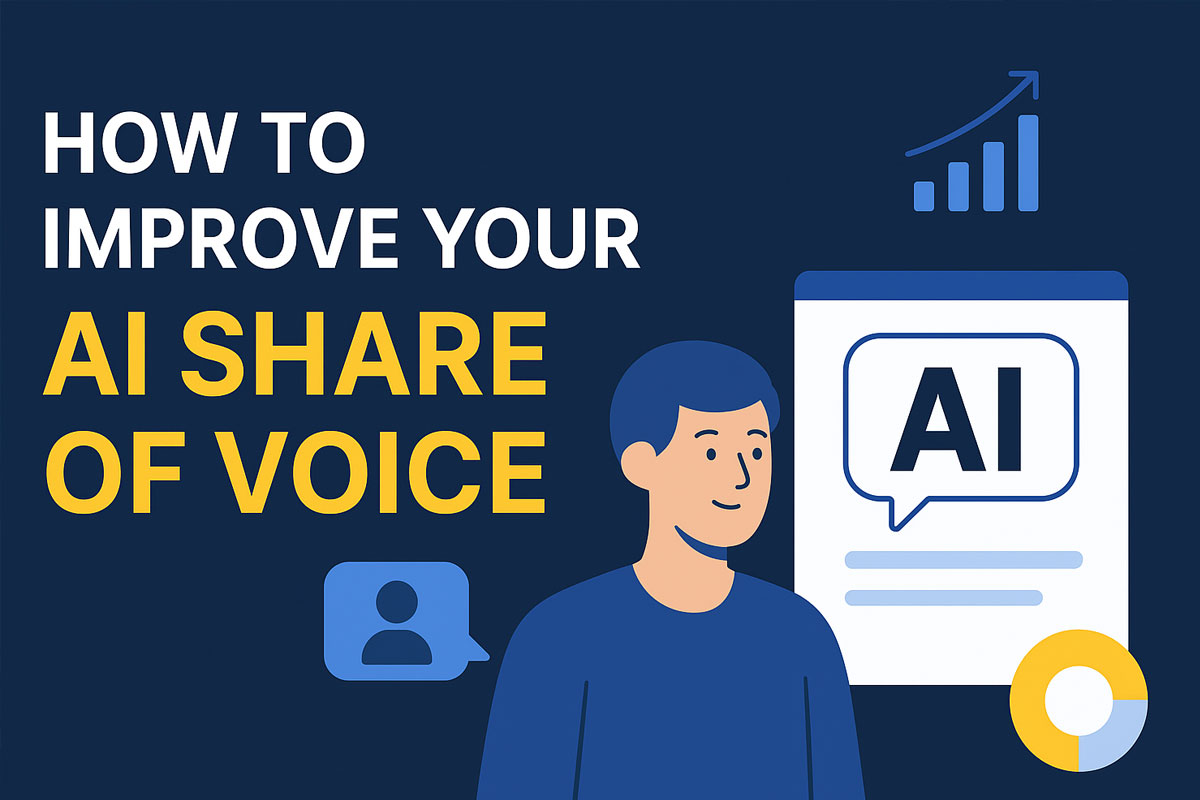In the fast-evolving digital landscape, organic search traffic — once the holy grail of online visibility — is steadily losing ground to AI-powered search. Since Google introduced AI Overviews and other platforms like ChatGPT, Perplexity, Gemini, and Claude began answering queries directly, websites are seeing notable declines in their organic visitors.
If your website traffic graph has been trending downward, you’re not alone. The reality is that users are no longer relying exclusively on traditional search engines to find answers — AI-driven responses are taking center stage.
So while it’s natural to focus on fixing your organic traffic, it’s even more critical to start monitoring your AI Share of Voice (AI SOV) — a new metric that defines your brand’s visibility in AI-generated search experiences.
Let’s explore why AI Share of Voice is quickly becoming more important than organic traffic, how to measure it, and what brands are doing to dominate this emerging frontier.
Understanding the Shift: From Organic Search to AI Search
For years, SEO professionals optimized their content to rank higher on Google SERPs, generating organic traffic through clicks. But the rules of search visibility have changed dramatically.
With AI Overviews and conversational AI systems like ChatGPT and Google Gemini, users often get comprehensive answers without visiting any website. The AI extracts, summarizes, and presents information instantly — making the need to “click through” obsolete in many cases.
According to Semrush research, AI-driven search traffic is projected to surpass traditional search visitors by early 2028, and in some industries, this shift may occur even sooner.
Meanwhile, OpenAI aims to reach 1 billion ChatGPT users by the end of 2025, and the adoption of other AI assistants is skyrocketing. Google’s “AI Mode” is transforming search into a full-blown conversational experience — one where users get everything they need in a single, AI-generated response.
If your brand isn’t being mentioned or cited within those responses, your organic traffic decline may only be the beginning.
That’s why your AI Share of Voice is now a mission-critical metric.
What Exactly Is AI Share of Voice (AI SOV)?
AI Share of Voice measures how often and prominently your brand appears in AI-generated answers compared to your competitors. It reflects how visible, credible, and trusted your brand is within AI-driven search ecosystems.
In simpler terms, your AI Share of Voice answers this question:
“When AI platforms like ChatGPT or Google’s AI Overview talk about my industry, how often does my brand come up?”
A higher AI SOV means your brand is being recognized and recommended by large language models (LLMs). It’s not about clicks — it’s about presence, authority, and reputation in the AI-driven search environment.
How AI Share of Voice Is Calculated

The basic AI Share of Voice formula is:
(Your Brand Mentions ÷ Total Industry Mentions) × 100 = AI SOV%
For example, if AI-generated responses mention your brand 30 times out of 120 total mentions across your category, your AI Share of Voice is 25%.
But there’s more to it than just counting mentions. Position and sentiment matter just as much as frequency.
Being mentioned first in an AI response carries significantly more weight than being mentioned at the end. Similarly, being cited in a positive context (e.g., “Top-rated solution” or “Trusted provider”) strengthens your brand’s credibility far more than a neutral or negative mention.
That’s why tools like Semrush’s AI Visibility Toolkit factor in both frequency and placement within AI-generated content to deliver a more precise and actionable SOV score.
AI Share of Voice vs. Traditional Share of Voice
Traditionally, “Share of Voice” was used to measure how much visibility a brand had across paid ads, social media, and organic search rankings. Marketers optimized these channels for impressions, clicks, and conversions.
AI Share of Voice, however, represents a paradigm shift. AI doesn’t necessarily drive users to your site — it cites your brand directly within its response.
That means your goal isn’t just to rank high on Google anymore — it’s to become the brand AI systems trust enough to mention.
AI’s Data Sources Fall into Two Key Categories:
- Discovery Sources
These include user-generated content from Reddit, Quora, YouTube comments, forums, and review sites. AI systems analyze these discussions to gauge public sentiment and brand popularity. When people discuss your brand positively in these forums, AI picks up those signals and interprets them as credibility. - Authority Sources
These are factual, structured content repositories such as your website, Wikipedia, press releases, and reputable publications. AI systems rely on these sources to validate information and ensure reliability.
To win in AI-driven visibility, your brand must dominate both categories — you need active, positive user discussions and authoritative content that reinforces those opinions.
Why Sentiment Matters in AI Share of Voice
Unlike traditional SEO, where visibility alone can drive results, AI visibility requires positive sentiment.
AI models analyze tone, context, and audience perception. A negative mention (“avoid this brand”) can harm your brand more than being left out entirely.
This makes reputation management a key factor in AI SEO. Monitoring your mentions and ensuring positive brand sentiment across forums, reviews, and authoritative content can significantly enhance your AI Share of Voice.
Brands That Are Winning the AI Share of Voice Game
Leading companies are already adapting their SEO strategies for AI visibility — and their results show it.
According to Semrush’s AI Visibility Index, here are a few standout examples:
1. HubSpot

HubSpot commands a 3.3% AI Share of Voice within ChatGPT’s business and professional services category, outranking competitors like Salesforce and QuickBooks.
Their strategy?
HubSpot maintains a balance between community discussions (through educational content and user engagement) and authority-building assets (like research papers, blogs, and product guides).
2. Zapier
Zapier ranks among the top brands cited by Google’s AI Mode for digital technology but falls lower in user-driven mentions.
The reason: Zapier’s extensive integration guides and knowledge base give it strong authority recognition, but competitors are mentioned more often in user forums.
3. Travel + Leisure, Good Housekeeping, and NerdWallet
These well-known publishers consistently rank high in Google’s AI Overviews because of their high-authority content. Their credibility in traditional SEO has naturally extended into AI-generated visibility.
Interestingly, fewer than 20% of brands excel at both frequent mentions and high authority. The real winners — like HubSpot — dominate both spaces.
How to Measure Your AI Share of Voice
Measuring AI Share of Voice helps you understand where you stand today — and what actions will help you strengthen your position.
Here are the most effective methods:
1. The Manual Tracking Method
If you’re just starting out, you can measure AI SOV manually:
- Open AI tools like ChatGPT, Google AI Mode, or Perplexity.
- Enter queries your target audience might use, such as “best CRM for small businesses” or “top industrial software tools.”
- Track how often your brand appears and note whether it’s mentioned first, in the middle, or last.
- Record the tone (positive, neutral, or negative).
Do this for 20–30 relevant prompts monthly, and calculate your brand’s visibility percentage.
Although this method provides useful insights, it’s time-consuming and doesn’t scale well across competitors.
2. Using the Semrush AI Visibility Toolkit

The Semrush AI Visibility Toolkit automates the entire process, providing a deep, data-driven analysis of your AI visibility.
You can view:
- Share of Voice percentages
- Number of AI mentions
- Sentiment trends
- Prompts that trigger your brand mentions
- Competitor benchmarking
One particularly valuable feature is the Share of Voice vs. Sentiment report, which visualizes both visibility and tone — showing not just how often you’re mentioned but how positively your brand is perceived.
For enterprises, Semrush Enterprise AIO offers expanded coverage across multiple AI platforms, including ChatGPT, Claude, Perplexity, and Gemini.

3. HubSpot’s AEO (AI Engine Optimization) Grader
HubSpot’s AEO Grader Tool is a free, user-friendly way to check your brand’s performance across major AI systems.
It analyzes how frequently ChatGPT, Gemini, and Perplexity reference your brand and compares you to competitors in your niche.
You’ll receive a detailed report showing your overall visibility, sentiment rating, and actionable insights to improve your AI search footprint.
4. Emerging AI Monitoring Tools
Several new AI analytics tools are entering the market, including:
- Otterly.ai – Monitors AI search mentions and trends across platforms.
- Profound – Offers detailed sentiment and position tracking.
- Scrunch – Focuses on influencer-driven AI visibility metrics.
While each platform takes a slightly different approach, the key takeaway is simple: start tracking your AI visibility now.
You can’t improve what you don’t measure.
Strategies to Improve Your AI Share of Voice
Now that you understand what AI SOV is and how to measure it, let’s look at practical strategies to increase it.
- Create Authoritative, Structured Content
Publish fact-based, data-driven, and clearly structured content. Use schema markup, FAQs, and summary tables to help AI easily parse and cite your pages. - Build Positive Community Engagement
Participate in Reddit, Quora, and niche forums. Encourage satisfied customers to discuss their experiences publicly. - Optimize for Conversational Search
Use natural language phrasing in your content — write the way people ask questions. This helps AI models understand and reference your material in conversational responses. - Earn Citations on Reputable Sources
Secure backlinks and citations from trusted domains, news outlets, and review platforms. The more authoritative your brand appears, the more likely AI will reference it. - Monitor and Manage Sentiment
Use brand monitoring tools to identify negative mentions early. Respond professionally and work to maintain a positive brand image. - Experiment with AI SEO Tools
Tools like Semrush, HubSpot AEO, and emerging platforms give you data-driven insights to fine-tune your AI visibility strategy.
How to Improve Your AI Share of Voice and Dominate AI Search Results
As artificial intelligence continues to reshape the way people search for information, traditional SEO metrics like keyword ranking and organic clicks are no longer the only benchmarks that matter. With tools like Google’s AI Overviews, ChatGPT, Perplexity, and Gemini now delivering direct answers to users, your brand’s visibility in AI-generated responses has become a major growth factor.
That visibility is measured by a new metric: AI Share of Voice (AI SOV) — the percentage of times your brand appears in AI-generated results compared to competitors in your niche.
Improving your AI Share of Voice requires more than good SEO; it demands a strategic approach that builds your brand presence across both discovery and authority sources. If you want your company to be the name AI assistants recommend and cite, this guide will show you how to get there.
1. Strengthen Your Brand Mentions Across the Web
AI systems don’t operate in isolation — they learn from the massive pool of data available online. Every forum post, customer review, social discussion, and press article about your brand helps LLMs (Large Language Models) understand your relevance and reputation.
The more often your brand is mentioned in these discussions, the greater the likelihood that AI platforms will reference you when generating responses.
Actionable Ways to Build Mentions:
- Engage in Niche Communities: Join Reddit discussions, Quora threads, and professional forums related to your industry. Instead of blatant promotion, contribute genuinely useful advice or insights that showcase your expertise.
- Encourage Customer Reviews: Ask satisfied customers to share honest feedback on trusted review platforms like G2, Capterra, or Trustpilot. Positive mentions from real users are gold for AI visibility.
- Leverage Digital PR: Reach out to online publications, bloggers, and news outlets within your niche. Share your brand’s data insights, research, or expert opinions. Every earned mention builds authority in both human and AI perception.
- Collaborate with Influencers: Partner with thought leaders who can authentically mention or review your brand. These mentions not only reach new audiences but also get indexed in AI training data over time.
A consistent flow of authentic mentions across high-authority platforms signals to AI models that your brand is trusted and relevant — making it more likely to appear in conversational results.
2. Create Content for Specific Use Cases and Niches
Generic content no longer earns top visibility in AI-generated search. Modern AI systems prioritize niche, context-rich, and question-specific content that directly answers user intent.
Rather than writing broad “ultimate guides,” create content designed for micro-segments of your audience.
For example, instead of targeting the term “CRM software,” produce detailed content around:
- “Best CRM software for small real estate teams”
- “CRM for accountants that integrates with QuickBooks”
- “Customer relationship tools for eCommerce startups”
Why It Works:
AI search results thrive on relevance. When a user asks a specific question like “What’s the best CRM for law firms?” — the AI is far more likely to reference content that directly matches that intent, not a general article about CRMs.
How to Do It:
- Analyze your customer support queries and turn them into topic-specific blog posts.
- Use FAQ-style pages and how-to guides that answer real, detailed questions.
- Incorporate structured data and conversational phrasing in your writing to align with how people talk to AI models.
This approach helps AI recognize your brand as a relevant and knowledgeable source for specific search intents, increasing the chances you’re cited or recommended.
3. Maintain Consistent Brand Messaging Everywhere
AI systems learn from all instances of your brand across the web — from your website to your LinkedIn bio, review pages, and Reddit mentions. If the language describing your brand varies drastically across these sources, it can confuse AI algorithms, making them less likely to represent your brand accurately.
How to Maintain Consistency:
- Develop a brand messaging guide that clearly outlines your mission, tone, and key differentiators.
- Use the same core descriptions, taglines, and benefits across your website, social profiles, and press content.
- Audit your online presence quarterly to ensure all mentions align with your preferred messaging.
Example:
If your homepage says you’re a “data analytics platform for startups,” but your LinkedIn says “AI-powered business intelligence software,” AI might not recognize both as the same entity.
Consistency makes it easier for LLMs to connect all your mentions into one unified brand identity, improving visibility and credibility across AI-driven search results.
4. Publish Machine-Readable, Structured Data
The way your content is structured plays a massive role in how easily AI systems can read, interpret, and quote it. Machine-readable formats help AI quickly extract the most relevant facts about your brand or products.
Best Practices for Structuring Content:
- Use clear headers (H2s and H3s) to segment topics logically.
- Add bullet points, numbered lists, and callouts to summarize key information.
- Include FAQ sections at the end of major pages — AI models love referencing FAQ-style answers.
- Implement schema markup (especially JSON-LD) to provide structured metadata about your organization, products, reviews, and FAQs.
Example:
If you have a product page for “Industrial Water Treatment Systems,” include schema data for product specs, ratings, price range, and customer reviews. This structured data helps AI extract accurate, bite-sized details about your offerings.
In short, the easier your content is to parse, the higher your chances of being cited in AI-generated responses.
5. Monitor and Improve Brand Sentiment
It’s not enough to be mentioned — how you’re mentioned matters just as much. Negative sentiment can actually decrease your AI visibility.
AI models are increasingly sophisticated at analyzing tone and context. A negative Reddit post or a poor review may weigh against your credibility during AI’s decision-making process.
Steps to Manage Sentiment Effectively:
- Use brand monitoring tools (like Brand24, Semrush, or Mention) to track your mentions and sentiment across social and review platforms.
- Respond professionally to negative feedback. A prompt, empathetic response demonstrates brand accountability — something AI systems interpret as trustworthiness.
- Feature case studies and testimonials on your website to push positive sentiment higher in your brand data.
- Collaborate with industry advocates and experts to produce content that paints your brand in a positive light.
Finally, include FAQs or knowledge base articles addressing common misconceptions or pain points. These are often used by AI models to craft balanced responses, ensuring your brand’s perspective is represented fairly.
6. Continue Optimizing for Traditional SEO
Despite the rise of AI search, traditional SEO remains vital. Many signals that help your site rank organically also enhance your AI visibility. Google’s AI Overviews, for example, still rely heavily on crawlable, high-quality web pages.
Traditional SEO Practices That Boost AI SOV:
- Optimize for topic clusters — create interlinked pages around major themes.
- Build authoritative backlinks to improve your site’s trust score.
- Ensure technical SEO (fast load times, mobile-friendly design, proper indexing) is solid.
- Use semantic keywords and long-tail questions that align with natural, conversational phrasing.
However, it’s important to note that ranking #1 on Google doesn’t automatically mean AI systems will cite you.
AI platforms analyze content relevance, authority, and structure, not just search rankings. Focus on producing high-quality, easily digestible “content chunks” that answer questions clearly and concisely.
7. Track and Measure Your AI Share of Voice
Just like traditional SEO metrics, AI Share of Voice can only be improved if it’s measured regularly. You need visibility into how frequently AI platforms mention your brand, what sentiment surrounds those mentions, and where your competitors stand.
Tools for Measuring AI SOV:
- Semrush AI Visibility Toolkit: Offers in-depth reports showing brand mentions, sentiment trends, and AI citation frequency across ChatGPT, Gemini, and other AI platforms.
- HubSpot’s AEO Grader: A free tool that compares your brand’s AI visibility and sentiment against competitors.
- Emerging Tools: Platforms like Otterly.ai, Profound, and Scrunch are developing new methods for tracking AI search performance.
You can also perform manual tracking by running searches in ChatGPT or Perplexity and noting how often your brand appears for relevant prompts. This approach is time-intensive but provides direct insights into your AI visibility.
8. Shape the Future by Acting Early
The earlier you start optimizing for AI visibility, the stronger your long-term position will be.
Large Language Models learn continuously by analyzing patterns across the web. By actively shaping those patterns now — through consistent mentions, positive sentiment, and structured content — your brand can become deeply embedded in AI systems’ understanding of your industry.
Key Takeaways:
- Start tracking your AI Share of Voice today to establish a performance baseline.
- Analyze where competitors are outperforming you in AI mentions and sentiment.
- Develop a plan to grow both your discovery sources (conversations, reviews, forums) and authority sources (press coverage, structured data, citations).
- Monitor progress monthly using AI visibility tools and adjust your strategy accordingly.
The brands that act today will dominate tomorrow’s AI-driven discovery landscape. Waiting until AI completely overtakes traditional search could mean losing your digital visibility altogether.
The Bottom Line: Future-Proof Your Visibility
The age of click-based SEO dominance is fading fast. As AI systems take over how users discover and evaluate information, your brand’s AI Share of Voice will define your future success online.
Focusing solely on organic traffic today is like optimizing for desktop users in a mobile-first world — it’s missing the bigger picture.
If you start tracking and optimizing your AI Share of Voice now, you’ll not only safeguard your brand visibility but also lead your industry into the next era of digital discovery.

